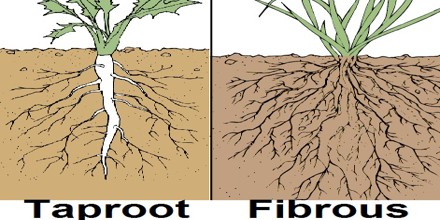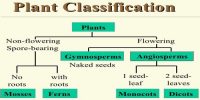If you observe, you will see that the roots of all the plants are not the same. The root of a mango or chili plant is different from that of paddy, corn or grass. Owing to such differences, roots can be mainly divided into two types in terms of their origin and location.
The two types of roots are – 1) Taproot and 2) Adventitious root.
(1) Taproot: The radicle of this type of root grows directly as it goes down the ground and lateral branches grow out of it. It is the primary root that develops from a radicle and becomes dominant. They are a single primary root that grows deep into the soil. These roots provide a very strong anchorage. The cause for this strong maintain is that they go through deep into the soil.For example, the roots of radish, mango, blackberry, chili, mustard, etc. The roots of dicotyledonous plants are tap roots. From taproot secondary roots arise. This type of root is a straight elongation of the radical.
Characteristics:
- Taproots develop from radical of an embryo
- They are always under the surface of the soil
- They have one primary root with branches that grow in an acropetal manner
- The primary root remains throughout the life of the plant
Dicotyledonous plants have two cotyledons. The taproot system is formed by the taproot of a dicotyledonous plant and as lateral roots. The root system of mango, blackberry, chili, mustard and nayantara trees have this type of root.

(2) Adventitious root: This type of roots originates not from the radicle rather from the stem and leaf. Examples of such roots are the roots of coconut, the taproot of a banyan tree and the stilt root of the screw pine tree. It develops from the parts of a plant other than radicle. However, they can be underground or aerial. Usually, they grow from intermodal, stem nodes, and leaves. They also develop in cases of plant injury. It is of two types – (a) Fibrous root and (b) Non Fibrous root.
(a) Fibrous root: It originates from the base of the stem. If you watch the roots of paddy, grass, bamboo etc, you will notice, a group of fiber-like roots growing from the stem. These are fibrous roots. The primary root is short-lived and is replaced by a large number of roots. This type of roots may grow when the radicle is lost and a group of fibre like roots grows from the same place. These roots tend to raise close to the surface and increase parallel. They are slender, branched, and grow directly from the stem. Examples – roots of paddy, coconut and betel nut plants, also all monocot plants.
They are characterized by a cluster-like form with several roots jointly, almost of a similar size.
Characteristics:
- These roots grow from the base of the stem
- They are present in the appearance of clusters of similar-sized roots
- The primary root is replaced by adventitious roots
- They do not go through deep into the soil.
(b) Non Fibrous root: The adventitious roots that do not grow in a cluster, rather develop separately from one another are non-fibrous roots. This root system does not give tough anchorage to the plant as they go through deep into the soil. Example – Stilt root of screw pine, prop root of the Banyan tree are of this kind.
Some other minor types of roots depending upon the type and species of plants are –
- Creeping Roots are the types of roots that do not go through deep into the soil.
- Tuberous Roots are very thick roots. They store major amounts of food to feed the whole plant. They are an ample, inflamed, and modified storage organ.
- Water Roots are the types of roots that plants in water grow. They have the capability to allow oxygen from the atmosphere to disseminate in which is then used by the roots for growth.
- Parasite Roots are types of roots that connect themselves to the other plant and suck nutrients from it. They do not offer any advantage to the host plant.














